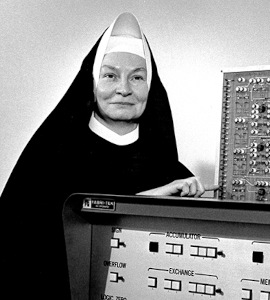The Association for Computing Machinery (ACM) is a US-based international learned society for computing. It was founded in 1947 and is the world's largest scientific and educational computing society. The ACM is a non-profit professional membership group, reporting nearly 110,000 student and professional members as of 2022. Its headquarters are in New York City.

Sir Charles Antony Richard Hoarehor is a British computer scientist who has made foundational contributions to programming languages, algorithms, operating systems, formal verification, and concurrent computing. His work earned him the Turing Award, usually regarded as the highest distinction in computer science, in 1980.
A special interest group (SIG) is a community within a larger organization with a shared interest in advancing a specific area of knowledge, learning or technology where members cooperate to effect or to produce solutions within their particular field, and may communicate, meet, and organize conferences. The term was used in 1961 by the Association for Computing Machinery (ACM), an academic and professional computer society. SIG was later popularized on CompuServe, an early online service provider, where SIGs were a section of the service devoted to particular interests.

ACM SIGGRAPH is the international Association for Computing Machinery's Special Interest Group on Computer Graphics and Interactive Techniques based in New York. It was founded in 1969 by Andy van Dam.
ACM SIGACT or SIGACT is the Association for Computing Machinery Special Interest Group on Algorithms and Computation Theory, whose purpose is support of research in theoretical computer science. It was founded in 1968 by Patrick C. Fischer.
The Eckert–Mauchly Award recognizes contributions to digital systems and computer architecture. It is known as the computer architecture community’s most prestigious award. First awarded in 1979, it was named for John Presper Eckert and John William Mauchly, who between 1943 and 1946 collaborated on the design and construction of the first large scale electronic computing machine, known as ENIAC, the Electronic Numerical Integrator and Computer. A certificate and $5,000 are awarded jointly by the Association for Computing Machinery (ACM) and the IEEE Computer Society for outstanding contributions to the field of computer and digital systems architecture.

The Donald E. Knuth Prize is a prize for outstanding contributions to the foundations of computer science, named after the American computer scientist Donald E. Knuth.
The Special Interest Group on Computer–Human Interaction (SIGCHI) is one of the Association for Computing Machinery's special interest groups which is focused on human–computer interactions (HCI).
ACM SIGACCESS is the Association for Computing Machinery's Special Interest Group on accessible computing, an interdisciplinary group of academic and industrial researchers, clinicians and rehabilitation personnel, policy makers, end users, and students to develop technologies for use by people with disabilities.
SIGUCCS is an association of professionals who support and manage the diverse aspects of information technology services at higher education institutions by providing professional development opportunities for SIGUCCS members and other individuals in the field. SIGUCCS is one of 34 special interest groups of ACM, the Association for Computing Machinery, the world’s largest educational and scientific computing society.
Bruce Gilchrist is considered one of the notable figures in modern computing history.
Shriram Krishnamurthi is a computer scientist, currently a professor of computer science at Brown University and a member of the core development group for the Racket programming languages, responsible for creation of software packages including the Debugger, the FrTime package, and the networking library. Since 2006, Krishnamurthi has been a leading contributor to the Bootstrap curriculum, a project to integrate computer science education into grades 6–12.
The German Informatics Society (GI) is a German professional society for computer science, with around 20,000 personal and 250 corporate members. It is the biggest organized representation of its kind in the German-speaking world.

Mary Kenneth Keller, B.V.M. was an American Catholic religious sister, educator and pioneer in computer science. She was the first person to earn a Ph.D. in computer science in the United States. Keller and Irving C. Tang were the first two recipients of computer science doctorates.
SIGWEB is a Special Interest Group of the Association for Computing Machinery (ACM) on hypertext, hypermedia, and the World Wide Web. SIGWEB was named SIGLINK until November 1998.
The Association for Computing Machinery Special Interest Group on University and College Computing Services Hall of Fame Award was established by the Association for Computing Machinery to recognize individuals whose specific contributions have had a positive impact on the organization and therefore on the professional careers of the members and their institutions.
Lorraine Borman is an American computer scientist associated with Northwestern University who specializes in information retrieval, computational social science, and human–computer interaction. She was one of the founders of SIGCHI, the Special Interest Group on Computer–Human Interaction of the Association for Computing Machinery, and became its first chair.

ACM SIGAI is the Association for Computing Machinery's Special Interest Group on Artificial Intelligence (AI), an interdisciplinary group of academic and industrial researchers, practitioners, software developers, end users, and students who work together to promote and support the growth and application of AI principles and techniques throughout computing. SIGAI is one of the oldest special interest groups in the ACM. SIGAI, previously called SIGART, started in 1966, publishing the SIGART Newsletter that later became the SIGART Bulletin and Intelligence Magazine.

ACM SIGARCH is the Association for Computing Machinery's Special Interest Group on computer architecture, a community of computer professionals and students from academia and industry involved in research and professional practice related to computer architecture and design. The organization sponsors many prestigious international conferences in this area, including the International Symposium on Computer Architecture (ISCA), recognized as the top conference in this area since 1975. Together with IEEE Computer Society's Technical Committee on Computer Architecture (TCCA), it is one of the two main professional organizations for people working in computer architecture.





